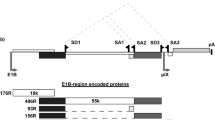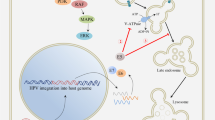Abstract
Rapid advances are being made in the engineering of replication-competent viruses to treat cancer. Adenovirus is a mildly pathogenic human virus that propagates prolifically in epithelial cells, the origin of most human cancers. While virologists have revealed many details about its molecular interactions with the cell, applied scientists have developed powerful technologies to genetically modify or regulate every viral protein. In tandem, the limited success of nonreplicative adenoviral vectors in cancer gene therapy has brought the old concept of adenovirus oncolysis back into the spotlight. Major efforts have been directed toward achieving selective replication by the deletion of viral functions dispensable in tumor cells or by the regulation of viral genes with tumor-specific promoters. However, the predicted replication selectivity has not been realized because of incomplete knowledge of the complex virus–cell interactions and the leakiness of cellular promoters in the viral genome. Capsid modifications are being developed to achieve tumor targeting and enhance infectivity. Cellular and viral functions that confer greater oncolytic potency are also being elucidated. Ultimately, the interplay of the virus with the immune system will likely dictate the success of this approach as a cancer therapy.
This is a preview of subscription content, access via your institution
Access options
Subscribe to this journal
Receive 12 print issues and online access
$209.00 per year
only $17.42 per issue
Buy this article
- Purchase on SpringerLink
- Instant access to full article PDF
Prices may be subject to local taxes which are calculated during checkout

Similar content being viewed by others
References
Sinkovics, J. & Horvath, J. New developments in the virus therapy of cancer: a historical review. Intervirology 36, 193–214 (1993).
Smith, R.R., Huebner, R.J., Rowe, W.P., Schatten, W.F. & Thomas, L.B. Studies on the use of viruses in the treatment of carcinoma of the cervix. Cancer 9, 1211–1218 (1956).
Coffey, M.C., Strong, J.E., Forsyth, P.A. & Lee, P.W. Reovirus therapy of tumors with activated Ras pathway. Science 282, 1332–1334 (1998).
Haag, A. et al. Highly efficient transduction and expression of cytokine genes in human tumor cells by means of autonomous parvovirus vectors; generation of antitumor responses in recipient mice. Hum. Gene Ther. 11, 597–609 (2000).
Yoon, S.S. et al. An oncolytic herpes simplex virus type 1 selectively destroys diffuse liver metastases from colon carcinoma. FASEB. J. 14, 301–311 (2000).
Ganly, I. et al. A phase I study of Onyx-015, an E1B attenuated adenovirus, administered intratumorally to patients with recurrent head and neck cancer. Clin. Cancer Res. 6, 798–806 (2000).
Lucher, L.A. Abortive adenovirus infection and host range determinants. Curr. Top. Microbiol. Immunol. 199, 119–152 (1995).
Hay, J.G. et al. Targeting the replication of adenoviral gene therapy vectors to lung cancer cells: the importance of the adenoviral E1b-55kD gene. Hum. Gene Ther. 10, 579–590 (1999).
Heise, C. et al. ONYX-015, an E1B gene-attenuated adenovirus, causes tumor-specific cytolysis and antitumoral efficacy that can be augmented by standard chemotherapeutic agents. Nat. Med. 3, 639–645 (1997).
Yu, D.C., Sakamoto, G.T. & Henderson, D.R. Identification of the transcriptional regulatory sequences of human kallikrein 2 and their use in the construction of calydon virus 764, an attenuated replication competent adenovirus for prostate cancer therapy. Cancer Res. 59, 1498–504 (1999).
Rothmann, T., Hengstermann, A., Whitaker, N.J., Scheffner, M. & zur Hausen, H. Replication of ONYX-015, a potential anticancer adenovirus, is independent of p53 status in tumor cells. J. Virol. 72, 9470–9478 (1998).
Lu, D. et al. Altered expression of CD44 and variant isoforms in human adenocarcinoma of the endocervix during progression. Gynecol. Oncol. 75, 84–90 (1999).
Bischoff, J.R. et al. An adenovirus mutant that replicates selectively in p53-deficient human tumor cells. Science 274, 373–376 (1996).
Goodrum, F.D. & Ornelles, D.A. p53 status does not determine outcome of E1B 55-kilodalton mutant adenovirus lytic infection. J. Virol. 72, 9479–9490 (1998).
Babiss, L.E. & Ginsberg, H.S. Adenovirus type 5 early region 1b gene product is required for efficient shutoff of host protein synthesis. J. Virol. 50, 202–212 (1984).
Pilder, S., Moore, M., Logan, J. & Shenk, T. The adenovirus E1B-55K transforming polypeptide modulates transport or cytoplasmic stabilization of viral and host cell mRNAs. Mol. Cell Biol. 6, 470–476 (1986).
Harada, J.N. & Berk, A.J. p53-Independent and -dependent requirements for E1B-55K in adenovirus type 5 replication. J. Virol. 73, 5333–5344 (1999).
Hall, A.R., Dix, B.R., O'Carroll, S.J. & Braithwaite, A.W. p53-dependent cell death/apoptosis is required for a productive adenovirus infection. Nat. Med. 4, 1068–1072 (1998).
Wildner, O., Blaese, R.M. & Morris, J.C. Therapy of colon cancer with oncolytic adenovirus is enhanced by the addition of herpes simplex virus–thymidine kinase. Cancer Res. 59, 410–413 (1999).
Rogulski, K.R. et al. Double suicide gene therapy augments the antitumor activity of a replication-competent lytic adenovirus through enhanced cytotoxicity and radiosensitization. Hum. Gene Ther. 11, 67–76 (2000).
Fueyo, J. et al. A mutant oncolytic adenovirus targeting the Rb pathway produces anti-glioma effect in vivo. Oncogene 19, 2–12 (2000).
Wang, H.G., Moran, E. & Yaciuk, P. E1A promotes association between p300 and pRB in multimeric complexes required for normal biological activity. J. Virol. 69, 7917–7924 (1995).
Hallenbeck, P.L. et al. A novel tumor-specific replication-restricted adenoviral vector for gene therapy of hepatocellular carcinoma. Hum. Gene Ther. 10, 1721–33 (1999).
Rodriguez, R. et al. Prostate attenuated replication competent adenovirus (ARCA) CN706: a selective cytotoxic for prostate-specific antigen-positive prostate cancer cells. Cancer Res. 57, 2559–2563 (1997).
Babiss, L.E., Friedman, J.M., Darnell, J.E. Jr. Cellular promoters incorporated into the adenovirus genome. Effect of viral DNA replication on endogenous and exogenous gene transcription. J Mol Biol 193, 643–650 (1987).
Vassaux, G., Hurst, H.C. & Lemoine, N.R. Insulation of a conditionally expressed transgene in an adenoviral vector. Gene Ther. 6, 1192–1197 (1999).
Goldsmith, K.T., Curiel, D.T., Engler, J.A. & Garver, RI Jr. Trans complementation of an E1A-deleted adenovirus with codelivered E1A sequences to make recombinant adenoviral producer cells. Hum. Gene Ther. 5, 1341–1348 (1994).
Tollefson, A.E. et al. The adenovirus death protein (E3-11.6K) is required at very late stages of infection for efficient cell lysis and release of adenovirus from infected cells. J. Virol. 70, 2296–2306 (1996).
Yu, D.C., Chen, Y., Seng, M., Dilley, J. & Henderson, D.R. The addition of adenovirus type 5 region E3 enables calydon virus 787 to eliminate distant prostate tumor xenografts. Cancer Res. 59, 4200–4203 (1999). (Published erratum appears in Cancer Res. 60, 1150, 2000).
Alemany, R. et al. Complementary adenoviral vectors for oncolysis. Cancer Gene Ther. 6, 21–25 (1999).
Motoi, F. et al. Effective gene therapy for pancreatic cancer by cytokines mediated by restricted replication-competent adenovirus. Hum. Gene Ther. 11, 223–235 (2000).
Duncan, S.J. et al. Infection of mouse liver by human adenovirus type 5. J. Gen. Virol. 40, 45–61 (1978).
Roelvink, P.W., Mi Lee, G., Einfeld, D.A., Kovesdi, I. & Wickham, T.J. Identification of a conserved receptor-binding site on the fiber proteins of CAR-recognizing adenoviridae. Science 286, 1568–1571 (1999).
Gabizon, A. et al. Prolonged circulation time and enhanced accumulation in malignant exudates of doxorubicin encapsulated in polyethylene-glycol coated liposomes. Cancer Res. 54, 987–992 (1994).
Gu, D.L. et al. Fibroblast growth factor 2 retargeted adenovirus has redirected cellular tropism: evidence for reduced toxicity and enhanced antitumor activity in mice. Cancer Res. 59, 2608–2614 (1999).
Curiel, D.T. Strategies to adapt adenoviral vectors for targeted delivery. Ann. NY Acad. Sci. 886, 158–171 (1999).
Dmitriev, I. et al. An adenovirus vector with genetically modified fibers demonstrates expanded tropism via utilization of a coxsackievirus and adenovirus receptor-independent cell entry mechanism. J. Virol. 72, 9706–9713 (1998).
Hemmi, S., Geertsen, R., Mezzacasa, A., Peter, I. & Dummer, R. The presence of human coxsackievirus and adenovirus receptor is associated with efficient adenovirus-mediated transgene expression in human melanoma cell cultures. Hum Gene Ther. 9, 2363–2373 (1998).
Li, Y. et al. Loss of adenoviral receptor expression in human bladder cancer cells: a potential impact on the efficacy of gene therapy. Cancer Res. 59, 325–330 (1999).
Staba, M.J., Wickham, T.J., Kovesdi, I. & Hallahan, D.E. Modifications of the fiber in adenovirus vectors increase tropism for malignant glioma models. Cancer Gene Ther. 7, 13–19 (2000).
Shinoura, N. et al. Highly augmented cytopathic effect of a fiber-mutant E1B-defective adenovirus for gene therapy of gliomas. Cancer Res. 59, 3411–3416 (1999).
Byrnes, A.P. & Griffin, D.E. Large-plaque mutants of Sindbis virus show reduced binding to heparan sulfate, heightened viremia, and slower clearance from the circulation. J. Virol. 74, 644–651 (2000).
Sauthoff, H., Heitner, S., Rom, W.N. & Hay, J.G. Deletion of the adenoviral E1b-19kD gene enhances tumor cell killing of a replicating adenoviral vector. Hum. Gene Ther. 11, 379–388 (2000).
Duque, P.M. et al. Antitumoral effect of E1B defective adenoviruses in human malignant cells. Gene Ther. 5, 286–287 (1998).
Zhang, Y. & Schneider, R.J. Adenovirus inhibition of cell translation facilitates release of virus particles and enhances degradation of the cytokeratin network. J. Virol. 68, 2544–2555 (1994).
Jain, R.K. Physiological barriers to delivery of monoclonal antibodies and other macromolecules in tumors. Cancer Res. 50, 814s–819s (1990).
Ikeda, K. et al. Oncolytic virus therapy of multiple tumors in the brain requires suppression of innate and elicited antiviral responses. Nat. Med. 5, 881–887 (1999).
Prince, G.A. et al. Pathogenesis of adenovirus type 5 pneumonia in cotton rats (Sigmodon hispidus). J. Virol. 67, 101–111 (1993).
Torres, J.M. et al. Tropism of human adenovirus type 5-based vectors in swine and their ability to protect against transmissible gastroenteritis coronavirus. J. Virol. 70, 3770–3780 (1996).
Oualikene, W., Gonin, P. & Eloit, M. Short and long term dissemination of deletion mutants of adenovirus in permissive (cotton rat) and non-permissive (mouse) species. J. Gen. Virol. 75, 2765–2768 (1994).
Khoobyarian, N., Barone, F., Sabet, T., El-Domeiri, A.A. & Das Gupta, T.K. Inhibition of melanoma growth in hamsters by type-2 adenovirus. J. Surg. Oncol. 7, 421–425 (1975).
Ganly, I., Mautner, V. & Balmain, A. Productive replication of human adenoviruses in mouse epidermal cells. J. Virol. 74, 2895–2899 (2000).
Yang, Y., Trinchieri, G. & Wilson, J.M. Recombinant IL-12 prevents formation of blocking IgA antibodies to recombinant adenovirus and allows repeated gene therapy to mouse lung. Nat. Med. 1, 890–893 (1995).
Zhang, J.F. et al. Treatment of a human breast cancer xenograft with an adenovirus vector containing an interferon gene results in rapid regression due to viral oncolysis and gene therapy. Proc. Natl. Acad. Sci. USA 93, 4513–4518 (1996).
Freytag, S.O., Rogulski, K.R., Paielli, D.L., Gilbert, J.D. & Kim, J.H. A novel three-pronged approach to kill cancer cells selectively: concomitant viral, double suicide gene, and radiotherapy. Hum. Gene Ther. 9, 1323–1333 (1998).
Rancourt, C. et al. Interleukin-6 modulated conditionally replicative adenovirus as an antitumor/cytotoxic agent for cancer therapy. Clin. Cancer Res. 5, 43–50 (1999).
Acknowledgements
The authors are grateful to Paul Reynolds and Kaori Suzuki for critical reading of the manuscript, supported by grants from: United States Department of Defense—PC 970193 and PC991018, Susan Komen Foundation, and National Institutes of Health—RO1 CA83821.
Author information
Authors and Affiliations
Corresponding author
Rights and permissions
About this article
Cite this article
Alemany, R., Balagué, C. & Curiel, D. Replicative adenoviruses for cancer therapy. Nat Biotechnol 18, 723–727 (2000). https://doi.org/10.1038/77283
Received:
Accepted:
Issue Date:
DOI: https://doi.org/10.1038/77283
This article is cited by
-
Mesenchymal stem cell-released oncolytic virus: an innovative strategy for cancer treatment
Cell Communication and Signaling (2023)
-
Cross-talk between cancer stem cells and immune cells: potential therapeutic targets in the tumor immune microenvironment
Molecular Cancer (2023)
-
Recent advancement of nanomedicine-based targeted delivery for cervical cancer treatment
Medical Oncology (2023)
-
A bibliometric review of oncolytic virus research as a novel approach for cancer therapy
Virology Journal (2021)
-
The armed oncolytic adenovirus ZD55-IL-24 eradicates melanoma by turning the tumor cells from the self-state into the nonself-state besides direct killing
Cell Death & Disease (2020)



